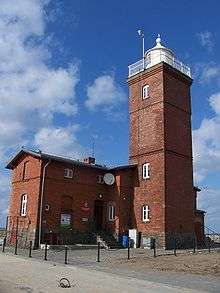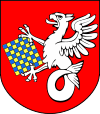Darłowo
Darłowo ([darˈwɔvɔ]) (in full The Royal City of Darłowo; Polish: Królewskie Miasto Darłowo, German: Rügenwalde; Kashubian: Dërłowò), is a seaside town in the West Pomeranian Region, at the south coast of the Baltic Sea, north-western Poland, with 14,931 inhabitants (as of 2016). Located in Sławno County in West Pomeranian Voivodeship since 1999, it was previously in the Koszalin Voivodeship (1950–1998).
Darłowo | |
|---|---|
.jpg) 
| |
 Coat of arms | |
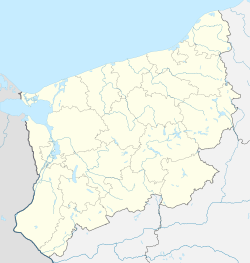 Darłowo  Darłowo | |
| Coordinates: 54°25′15″N 16°24′35″E | |
| Country | |
| Voivodeship | |
| County | Sławno |
| Gmina | Darłowo (urban gmina) |
| Area | |
| • Total | 19.93 km2 (7.70 sq mi) |
| Highest elevation | 5 m (16 ft) |
| Lowest elevation | 1 m (3 ft) |
| Population (2006) | |
| • Total | 14,931 |
| • Density | 750/km2 (1,900/sq mi) |
| Postal code | 76–150 and 76–153 |
| Website | http://www.darlowo.pl/ |
The earliest archaeological signs of a settlement in the area occurred when Roman merchants travelled along the Amber Road in the hope of trading precious metals like bronze and silver for amber.[1] By the 11th century the location of the later town was already becoming a significant trading point. The settlement received its city rights under Lübeck law from the wealthy Pomeranian nobles in 1312, which additionally contributed to the development of the town. Over the years Dukes of Pomerania constructed a Ducal Castle called Dirlow on a nearby island and chose it as their seat. In 1412 Rügenwalde (Darłowo) became part of the Hanseatic League and had its own trade fleet, larger than in other surrounding towns; it actively traded with Lübeck, while boats and ships owned by local merchants travelled as far as Normandy and Spain.[1]
In 1878 the town gained a railway connection to Danzig (Gdańsk) and Stettin (Szczecin); it simultaneously became a popular health resort, mainly due to the exceptional climate. Between 1871 and 1945, Rügenwalde (Darłowo) was part of Germany and was the site of a highly guarded military base. It was here that the largest artillery piece in the world, Schwerer Gustav, was constructed and tested by the Nazis during World War II.
The original medieval outline of Darłowo, based on the one in Lübeck with a typical square marketplace, has been preserved to this day. The Old Town, Ducal Castle and local beaches are popular among holidaymakers. Darłowo is also an important historical centre as it is the birthplace of Eric the Pomeranian, King of Denmark, Sweden and Norway.[2]
History
After the last Ice-age had ended at about 8000 BC, settlers of the Stone Age first populated the region.[3] Around 100 AD the region of the later town was inhabited by the East Germanic tribe of the Rugii. According to Ptolemy at the site of the later city was a settlement called Rugium.
Middle Ages
By the eleventh century a fortress named Dirlow, (or Dirlovo) existed where the River Wieprza entered the Baltic.[4] From this fortress, the district of Dirlow was administered, which belonged to the castelany of Sławno. A town was later founded in the district of Dirlow, but not at the location of the fortress itself.
The town was probably founded in 1270 by Wizlaw II of the Danish Principality of Rügen, at that time also ruler of the Lands of Schlawe and Stolp. The first mention of the town is in a document of 5 February 1271.[5] The settlement decayed.[6][7]
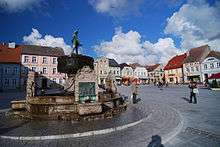
The town was destroyed in 1283 during a conflict between Wizlaw II and Mestwin II (Polish: Mszczuj or Mściwój).[8] In a chronicle of 1652, Matthäus Merian stated that the town had been destroyed by Bogislaw of Pomerania, when after Mestwin's II death in December 1294 the Duke Przemysł II (future king) of Poland acquired the town, as a consequence of Treaty of Kępno.
The town was rebuilt and on 21 May 1312, the town was granted Lübeck law under the administration of the noble brothers John, Peter, and Lawrence[9] of the Swienca family,[10] vassals of the Brandenburg margraves since 1307.[11] The Brandenburg margraves undertook in 1308 a campaign against Gdańsk.[6][12]
The town passed to the Duchy of Pomerania in 1347,[13] at that time ruled by the brothers Bogislaw V, Wartislaw V, and Barnim IV of the House of Pomerania dynasty. Bogislaw, son-in-law of king Casimir III of Poland, would become ruler of the area after the partition of Pomerania-Wolgast in 1368. This part duchy was known as Pomerania-Stolp (Duchy of Słupsk). Duke Bogislaw VIII, a Polish vassal, tried to direct Polish Baltic trade to the port of Darłowo, but without success.[14]
Transition to modern times
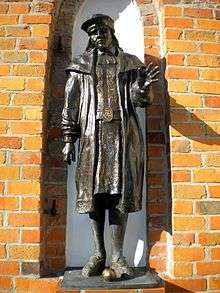
In 1352 the construction of the castle began, and co-operation with the Hanseatic League (Hanse) was initiated, with the town becoming a full member of the Hanse in 1412. In 1382 Eric of Pomerania, later the king of Norway, Denmark and Sweden, was born in the town. After losing his thrones, he returned to his birthplace and began to expand his duchy. After his death in 1459, he was buried in St. Mary's Church. After Eric's death, the town was ruled by Duke Eric II of Pomerania-Wolgast.[15]
Another significant ruler was Bogislaw X (1454–1523) under whose administration trade, domestic and international, grew increasing the prosperity of the area.
The town suffered a series of natural disasters. In 1497 and 1552 the harbour of the town, known in German as Rügenwaldermünde, and parts of the town were hit by great storms. Ships which broke from their moorings were seen drifting in the vicinity of the town and of the neighbouring village of Suckow. In 1589, 1624, 1648, 1679 and 1722 fires damaged the town.
After the death of the last Pomeranian Duke Bogislaw XIV in 1637, the end of the contemporary Thirty Years' War in 1648 and the subsequent partition of the Duchy of Pomerania between the Swedish Empire and Brandenburg-Prussia in the Peace of Westphalia and the Treaty of Stettin (1653), Brandenburg included Farther Pomerania with Rügenwalde in her Pomeranian province. The harbour of Rügenwaldermünde was destroyed during the Thirty Years' War by imperial troops, and was reconstructed by order of King Frederick II of Prussia not before 1772. The first lighthouse was built around the year 1715.
19th and 20th centuries
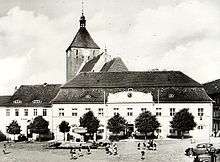
During the Napoleonic Wars some of Rügenwalde's inhabitants, in particular ship owners and businessmen, profited from smuggling British goods to the continent. In 1871 the town, along with Prussia, became a part of the German Empire. A railway reached the town in 1878. The Royal Swedish Vice Consulate was located in the town in 1859–1901 (Vice Consul Bertold August Riensberg, b. 1823) and in 1914–1936 (Vice Consul Albert Rubensohn, b. 1879).
In 1935 the German Army Firing Test Range Rügenwalde-Bad, designed for testing heavy guns, including long-range railway guns such as Krupp K5, was built between Rügenwalde's harbour Rügenwaldermünde and the village of Suckow.[16] Some of the largest guns in military history were tested here: Schwerer Gustav and Mörser Karl. Gun barrels with a length of up to 47 metres (154 feet) were tested. For long-distance tests, target areas within the Baltic Sea North of Großmöllendorf and Henkenhagen (about 80 kilometres (50 miles) away from Rügenwaldermünde) and North of Dievenow and Swinemünde (120 to 130 kilometres (75–81 miles) away) were used. The test site was visited by high-ranking officers of the German Army, Air Force and Navy, including Admiral of the Fleet Erich Raeder and field marshals von Rundstedt, Wilhelm Keitel and Hermann Göring.
After the end of World War II
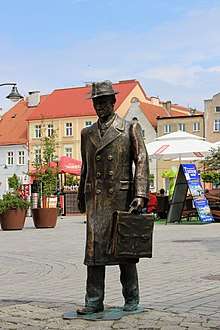
During World War II Rügenwalde was used to house families made homeless after the Allied bombing of Hagen and Bochum in the Ruhr district. Shortly before the end of World War II, numerous German refugees from East Prussia and West Prussia arrived in the region. In early 1945, about 5,600 people escaped by ships of Operation Hannibal before Soviet Troops reached the town on 7 March 1945. About 3,500 citizens remained in the town or returned again after failing to escape.[17]
Following the defeat of Nazi Germany, border changes promulgated at the Potsdam Conference assigned the town to Poland, and its German population was expelled.[18] The first expulsion of the surviving German inhabitants took place on 17 October 1945, followed by a series of further expulsions beginning on 17 August 1946. In 1949 only about 70 Germans were left in the town. In 1946–47, the town was repopulated with Poles and Lemkos, who partly came from what had been eastern Poland but was annexed by the Soviet Union.[19] The town was given the Polish name Dyrłów, and later Darłów, before changing to the current name.
The German name Rügenwalde was best known in Germany for the production of the Rügenwalder Teewurst in the town; after World War II the production was restarted in West Germany under the old name.
Today the Polish Darłowo is a summer resort. A coast aquapark with desalinated seawater is available there, the only one in Poland.
Main sights

The entire Old Town area in Darłowo has been entirely preserved. Darłowo has maintained the unique medieval urban planning with the main square in the middle of the town. During medieval times the town was surrounded by walls and had four gates; only one gate has survived in a fairly original shape.
Castle of Pomeranian Dukes
Although documents directly relating to the construction of the castle in Darłowo have not been found yet, the results of archaeological and architectural and historical premises allow us to date back the creation of the castle to the second half of the fourteenth century. It was during the reign of the prince of the House of Griffins, Boguslaw V and Elizabeth, the daughter of King Casimir the Great. The prince purchased the island with a mill in 1352 from a rich burgher of Darłowo – Elizabeth von Behr – in order to build a fortress on it. Over the decades, a castle had grown on the island, which in its main outlines has survived to this day. The work of Boguslaw V was at that time so representative that so that as early as in 1372 a congress of the Pomeranian princes – brothers and cousins Boguslaw took place within its walls. The first sovereign, who modernised the defence system and extended the castle was Prince Eric the Pomeranian. It took place in the years 1449 to 1459, when after the loss of the throne of Scandinavia, the dethroned king returned to his legacy.
An old king was accompanied by a beautiful and young servant-maid Cecilia, who was the love of his life. Historians still argue about who this mysterious woman really was. Some of them maintain that in the last years of his life, reaching his seventies – she became his wife. One of the contemporary chronicles mention her as "the queen Cecilia".
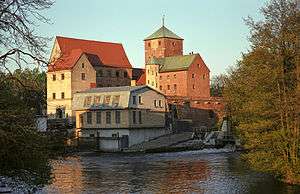
.jpg)
Shrouded in mystery, the history of the great love of King Eric and Cecilia became an inspiration for artists. The poem "The Return of the Prince Eric" was created by a poet and writer of Koszalin – Czeslaw Zea, and an American journalist and writer Lucie Lehmann – Barclay has been penetrating the archives of Denmark, Sweden, Norway, Germany and the UK for several years in search of traces of Cecilia and Eric. The aim of the writer is to create a love novel of this unique pair based on historical facts. The initial appearance of a medieval fortress of Darłowo was an inspiration to build a similar but larger Kronborg Castle by King Erik in Denmark, where after years, William Shakespeare placed the action of "Hamlet".
The castle of Darłowo is also associated with the figure of Eric Pomerania's granddaughter – Princess Sophia. Legend attributes to her, apparently contrary to the historical facts, cruelty, for which she lingers as the White Lady after her death, circling the castle. The character of Princess Sophia is also related to a romantic love story. The lady of the Darłowo castle was to bestow John of Maszewo with great reciprocating feeling. His Gothic tenement still stands today on the corner of the streets of Powstańców Warszawskich and Morska. Supposedly, the ducal castle was connected with the house of the knight with a secret underground passage, which the knight used at night to sneak into his Lady's... The historical novel based on the life of Princess Sophia, entitled "Beautiful Princess", was written by a writer Zbysław Gorecki living in Darłowo for many years. In the Prussian times, the castle served partly as a warehouse and fell into ruin. Only at the end of the thirties of the twentieth century, a regional museum was created there and it is operating. Its founder and first curator was Karl Rosenow.
Today the castle serves as a Polish Museum.[20] The castle is built in gothic style on a base plan resembling a square; its tower is 24 metres (79 feet) high. This is the only castle of such characteristic on the Polish seacoast.
The peculiarity of Darłowo museum is a two-headed calf, which was probably born in the village Janiewice, district of Sławno in 1919. Another interesting feature of the castle is a cat mummy and a golden sculpture of a dove – a talisman of luck for King Eric and Cecilia. Since the autumn of 2010, a statue of King Eric, showing the "king of exile" has been standing in the courtyard, funded by the Baltic Cooperative Bank in Darłowo.
St. Mary's Church
.jpg)
West Pomeranian Necropolis of the Dukes from the family of Griffins.
In 1321, Bishop Konrad Kamien gave the patronage to the church in Darłowo to the brothers Święce: Peter and Jasiek and Peter's son – Wawrzyniec. This year is considered to be the beginning of the construction of the Blessed Virgin Mary, known as St. Mary's Church.
The church was plagued fires in the years: 1589, 1624, 1679 and 1722. The fire in 1679, resulting from a lightning strike, burned down the entire interior of the church with a tower. From 1535 till the end of the hostilities in 1945, the church belonged to Protestants, most of whom lived in the area of Pomerania. At that time, there were many changes in church architecture. After the Second World War, along with Polish settlers, Catholic priests came to the city. On 14 August 1945, the Franciscans of the Province of Our Lady of Immaculate Conception took over the church and on 1 September of that same year, its consecration was made. Father Damian Tyniecki was the first parish priest. Since 1974, the church has been reconstructed to regain its Gothic roots. The balconies were removed, the plasters were knocked off from the rib vaulting in the nave and aisles; a bay and two gothic and medieval portals, well-preserved wall paintings in the chancel were exposed.
.jpg)
What deserves particular attention in St. Mary's Church in Darłowo is Pomeranian Mausoleum with the sarcophaguses of King Eric, Elizabeth, wife of the last Duke of Pomerania and Hedwig – Princess of Pomerania which is located in the chapel of the church tower.
It also possesses a richly decorated Baroque pulpit, probably from around 1700. Its body is embellished with reliefs of scenes from the life of Christ and biblical scenes. The pulpit is supported by the figure of an angel. The canopy is a scene of the Last Judgment. The church has a Baroque mural painting of Adoration of the Magi (seventeenth-eighteenth century) and a window painting of St. Christopher located in the walled bay. In addition, there are six portraits of the Apostles from the late seventeenth century, the Renaissance baptismal bowl from the sixteenth century, made in Nuremberg. Baptismal font carved in the plate is the work of an artist from Pomeranian Land – William Gross. It is located in the nave of the church, just below the balcony. Also worth mentioning: Baroque crucifix and the tabernacle from the seventeenth century, Baroque stalls from the seventeenth century, brass chandelier with an angel from the turn of the seventeenth and eighteenth centuries, and organ prospect from 1853. The neo-Gothic main altar comes from 1853. The images in the upper part show a figure of the Archangel. On the sides, there are figures of saints: Peter and Paul, carved in wood. In the aisles and chancel, note the carefully crafted stained glass windows.
The glass in the chancel shows Christ surrounded by the Evangelists. Moving south along the nave, we see among others a figure of St. Adalbert. Stained glass was funded by the Czech municipality Old Hrozenkov, with which the city of Darłowo cooperates under the partnership agreement. Right next to it, there is a crest of the city Darłowo which adorns another window of the temple.
In the hosts of the church, there is a quite specific lapidary. Collected remains come from the cemeteries of as many as four denominations: Catholic, Protestant, Orthodox, and Jewish. The first post-war pastor of the years 1945 – 1950 was Father Damian Tyniecki, who came to Darłowo from Radziejów on Kujawy, along with a large group of settlers from this region. To his honour, one the street has been called with his name.
Saint Gertrude Church
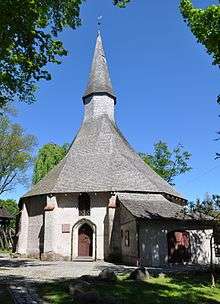
The elevation of the church is attributed to King Eric. He had to do it to commemorate his pilgrimage to the Holy Sepulchre in Jerusalem. The church was built in the fifteenth century on a plan of a hexagon with the twelve-sided bypass in Scandinavian-style Gothic. This is an exception in the whole Pomerania. Some scholars date back its construction to the years 1450 – 1460, i.e. the period of King Eric's stay in Darłowo (1449–1459). The Church of Saint Gertrude is shown on the map of a Pomeranian cartographer Lubinus, completed in 1618. The earliest mention of the Chapel of St. Gertrude comes from 1497, when Darłowo was hit by the largest-ever flood caused most likely by the tsunami waves called by his contemporaries the Bear Sea. Then, under the hill where the chapel stands, the waves threw ships. The tragic flooding caused the then parish priest, along with the mayor vow that from now on, every year a penance- pleading procession through the streets of Darłowo would take place. The tradition of the procession was revived in 1991. Currently, it takes place in September.
Gertrude's Church is almost a rotunda. In front of the altar, there are five balconies which balustrades are decorated with paintings funded by the shoemakers of Darłowo in the 17th and 18th centuries. There is a starry vault inside the church, neo-baroque organ prospect from 1912, the organs from 1860, which to this day not only serve the worshipers but also the Polish and international virtuosos during the annual summer organ festivals organised by Koszalin Philharmonic. The patroness of the church is Saint Gertrude of Nivelles, the guardian of sailors and travellers.[21]
Saint George Chapel
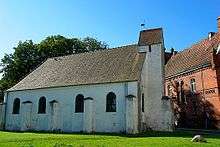
The smallest of the surviving medieval churches in Darłowo is brick, plastered, one-nave church of St. George from the 15th century. This type of hospital churches were built outside the city walls because of the spread of epidemics such as smallpox and leprosy. Two hospitals belonged to this church: the Holy Spirit, where there were the poor and the sick, and the Holy Jurgen, primarily serving the lepers. In 1680 and beyond, the church was surrounded by 30 clay huts, covered with reeds, where the sick and the senility lived. Around the huts, there were small vegetable gardens. People who lived in the huts, often cleaned Darłowo market, or worked as gravediggers and pallbearer. In the late nineteenth century, red-brick hospital in neo-Gothic style was built next to the church. Today it is a residential building.[22]
The Town Hall
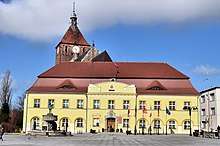
The old City Hall (Ratusz), which stood in the centre of the market, burned down during the great fire in 1722. Then, the municipal government moved to "Cloth Hall" of Darłowo – completely rebuilt halls, located near St. Mary's Church, which since 1725 years has been officially the town hall venue. The interior is non-historical. It is worth to notice the Renaissance portal remaining after the previous town hall, which is located above the door. Coat of arms of the city – a griffin with a tail of a fish – and an inscription in Latin, which in translation reads: "The city was founded in the 12th (the last two digits of the date has not been included because they were then known), the AD, was enlarged in 1312. Three times burned: 1589, 1624, 1648. as many times risen from the ashes. Kind to God and the prince, be always fortunate. Grow and flourish. May God make you happy and may Prince protect you for a long time. But the despair, the fire destroyed it again in 1675 and 1722 and the town hall was rebuilt in 1725 and let it be for the last time".
Dreams of the citizens came true. To this day, the Town Hall is home to the municipal government and the city – untouched – survived the march of the Red Army that won the Western Pomerania in winter of 1945. [23]
The Fountain – Fisherman Memorial
It has been located on Darłowo market since 1919. It was made by the sculptor Wilhelm Groß (1883–1974) from Sławno as a monument to honour the people of the sea. The founder of the fountain was the richest Darłowo shipowner – the one from the family of Hemptenmacher, whose house is located at the intersection of ul. Powstańców Warszawskich and ul. Rynkowa. What deserves the attention are four bronze plaques depicting the scenes from the life of the former inhabitants of Darłowo. The board from the side of the Town Hall presents a knight pointing an area where the city was founded. Beside him, there is a scribe and workers digging a ditch, having to circle the fortified castle. From the north, the artist presented the longshoremen working on the loading ship. On the eastern plate, there is koga floating on the waves of the Hanseatic. On the final relief, facing the south, it is shown how a shepherd is guarding a flock of sheep and a woman herding geese. Goose meat, especially liver were the best export product of the former Darłowo.
High Gate
.jpg)
The High Gate (Brama Wysoka) is one of the three city gates and the only one that survived until today. The residue of the old city fortifications that surrounded the city with a 1500-meter long wall. It was rebuilt in 1732. It is placed on a square, four-pointed arch crossing, covered with a hipped roof, decorated with pointed-arch blinds. Inside, there are still preserved bullet holes.
Lighthouse
Easternmost lighthouse that belongs to the West Coast is the lighthouse in Darłówek, built at the base of the eastern breakwater at the mouth Wieprza flowing into the Baltic Sea. The first mention of Darłowo lighthouse comes from 1715, when the city authorities ordered to set lights on both sides of the mouth of Wieprza.
It is known that it was only in 1885 when a small pilot ship station was built at the base of the eastern breakwater ground floor. It was a relatively tall red brick building, which adjoins a tower built in the square. At the turn of the nineteenth and twentieth century, the lighthouse underwent several upgrades. The lamp lenses were replaced and the power and colour of the light source were increased. In 1927, the tower was raised by one floor. The building is crowned with a white steel dome, where the light source was moved. Since then, the appearance of the whole building to the present day has undergone only cosmetic changes.
Today, the height of the tower is 22 metres (72 feet), and the range of light pointing the way to the port is nearly 30 kilometres (19 miles). The lighthouse is open for tourists in summer.
The lighthouse of Darłowo is the only lighthouse in Poland built on a rectangular plan.
Demographics
Since the Reformation had taken place in Pomerania, the vast majority of the city's population was composed of Protestants.
| Year | Number | Notes |
|---|---|---|
| 1740 | 1,973[24] | |
| 1782 | 2,255 | incl. 22 Jews[25] |
| 1791 | 2,331 | incl. 29 Jews.[26] |
| 1794 | 2,347 | incl. 29 Jews[25] |
| 1812 | 3,163 | incl. 47 Catholics and 33 Jews.[25] |
| 1817 | 3,754[27] | |
| 1831 | 3,393 | incl. 8 Catholics and 43 Jews.[25] |
| 1843 | 4,534 | incl. 18 Catholics and 67 Jews.[25] |
| 1852 | 5,060 | incl. 16 Catholics and 84 Jews.[25] |
| 1861 | 5,406 | incl. 5 Catholics and 117 Jews.[25] |
| 1875 | 5,174 | |
| 1890 | 5,296 | incl. 27 Catholics and 102 Jews |
| 1905 | 5,986 | incl. 27 Catholics and 74 Jews[28] |
| 1910 | 5,978 | |
| 1939 | 8,392 | |
| 1944 | approx. 11,000 | |
| 2008 | 14, 140 | |
| 2013 | 13,867 |
Notable people
- Eric of Pomerania KG (1381 or 1382 in Rügenwalde – 1459) the ruler of the Kalmar Union from 1396 until 1439,
- Bogislaw X, Duke of Pomerania (1454 in Rügenwalde – 1523) Duke of Pomerania from 1474 to 1523.
- August Koberstein (1797 in Rügenwalde – 1870) a German literary historian.[29]
- Jakub Kowalczyk (born 1986 in Darłowo) a Polish volleyball player.
International relations
Twin towns – sister cities
Darłowo is twinned with:
See also
Literature
- (in German) Helge Bei der Wieden and Roderich Schmidt, eds.: Handbuch der historischen Stätten Deutschlands: Mecklenburg/Pommern, Kröner, Stuttgart 1996, ISBN 978-3-520-31501-4, pp. 262–264.
- (in German) Gustav Kratz: Die Städte der Provinz Pommern – Abriß ihrer Geschichte, zumeist nach Urkunden, Berlin 1865, pp. 327–338 (online).
- (in German) Manfred Vollack (ed.): Der Kreis Schlawe – Ein pommersches Heimatbuch, Husum: Husum Druck und Verlagsgesellschaft, 1986/1989, Vol. I: Der Kreis als Ganzes, ISBN 3-88042-239-7, Vol. II: Die Städte und Landgemeinden, ISBN 3-88042-337-7 (The book contains several articles concerning the town of Rügenwalde, which had been written prior to World War II. Included is also a more recent article by Ellinor von Puttkamer on the Swienca family.)
References
- "Local history – Information about the town – Darłowo – Virtual Shtetl". Archived from the original on 29 March 2017. Retrieved 28 March 2017.
- "Królewskie Miasto Darłowo – darlowo.pl – serwis informacyjny, pomorze, wybrzeże, zabytki, wakacje, zdjecia, galeria, wypoczynek, wyszukiwarka, baza turystyczna, informacje dla turystow". Archived from the original on 12 June 2018. Retrieved 28 March 2017.
- As an example, near to the village of Schlawin, 10 kilometres (6.2 miles) away from the town, a 8.5-centimetre-long (3.35-inch) axe with a shaft hole, made from diorite, has been found, cf. 40. Jahresbericht der pommerschen Gesellschaft für Geschichte und Altertumskunde, 1877/1878, p. 463.
- E. Walter: Über Altertümer und Ausgrabungen in Pommern, Jahresbericht der Gesellschaft für pommersche Geschichte und Altertumskunde, 1. Mai 1914 bis 31. März 1915, Vol. 77, p. 280.
- Der Kreis Schlawe – Ein pommersches Heimatbuch (edited by Manfred Vollack and Ernst Hubert Michaelis, Heimatkreisausschuss Schlawe), Husum Druck- und Verlagsgesellschaft, Husum 1986, p. 698, ISBN 3-88042-337-7
- Werner Buchholz: Pommern, Siedler, 1999, pp.77–80, ISBN 3-88680-272-8
- Rembert Unterstell: Klio in Pommern – Die Geschichte der pommerschen Historiographie 1815 bis 1945, Böhlau, 1996, p.81, ISBN 3-412-14495-9
- Wielka Encyklopedia PWN [Great Encyclopaedia of Polish Scientific Publishing House], Warsaw 2001–2005, article on Darłowo.
- In the "Handfeste" document the brothers call themselves: "Petrus dei gracia comes de Nuwenburg et domines Johannes et Laurentius, felicis memoriae dominis Suensones filii"; in another document of 9 October 1313 they call themselves "Petrus, Jasco et Laurencius germani, dicti de Nuwenborch"; cites from Scriptores Rerum Prussicarum: Die Geschichtsquellen der Preussischen Vorzeit bis zum Untergange der Ordensherrschaft}}
- Eberhard Völker, Pommern und Ostbrandenburger, 2000, p.37, ISBN 3-7844-2756-1
- Radosław Gaziński, Paweł Gut, Maciej Szukała, Peter Oliver Loew, Archiwum Państwowe w Szczecinie, Poland Naczelna Dyrekcja Archiwów Państwowych, Archiwum Państwowe w Szczecinie, Poland, Naczelna Dyrekcja Archiwów Państwowych, Staatsarchiv Stettin- Wegweiser durch die Bestände bis zum Jahr 1945, Oldenbourg Wissenschaftsverlag, 2004, p.336 https://books.google.com/books?id=7ZmTZrs8dBEC&pg=PA336. Missing or empty
|title=(help) - Jan M Piskorski: Pommern im Wandel der Zeiten, 1999, p. 68, ISBN 83-906184-8-6 OCLC 43087092: rough translation: "In 1308 the Brandenburgians subdued the areas of Stolp, Schlawe, and Danzig. Despite their eviction from Danzig by the Teutonic knights, they stayed in charge of the mouths of the Wipper and Stolpe rivers."
- Werner Buchholz: Pommern, Siedler, 1999, p.105, ISBN 3-88680-272-8
- K. Kozłowski, J. Podralski, Gryfici. Książęta Pomorza Zachodniego, Krajowa Agencja Wydawnicza, Szczecin, 1985, p. 73.
- Gustav Kratz: Die Städte der Provinz Pommern, Vaduz: Sändig Reprint Verlag, 1996 (unchanged reprint of the edition of 1886), p. 332.
- Ulrich Ziervogel: Der Schießplatz in Rügenwalde-Bad, in: Der Kreis Schlawe – Ein pommersches Heimatbuch (M. Vollack, Hrsg.), Vol. I: Der Kreis als Ganzes, Husum 1986, ISBN 3-88042-239-7. pp. 294–296.
- Carlheinz Rosenow: Rügenwalde and der Ostsee – Kleine Geschichte der Heimatstadt, in: Der Kreis Schlawe, Vol. II, Husum 1989, pp. 687–698.
- Manfred Vollack (ed.): Der Kreis Schlawe, Vol. I: Der Kreis als Ganzes, Vol. II: Die Städte und Landgemeinden, Husum 1986/1989.
- Sword, Keith (25 June 1991). "The Soviet Takeover of the Polish Eastern Provinces, 1939–41". Springer.
- Karl Rosenow: Das Herzogsschloß zu Rügenwalde – Seine Geschichte,in: Der Kreis Schlawe – Ein pommersches Heimatbuch (M.Vollack, ed.), Vol.II: Die Städte und Landgemeinden, Husum 1989, ISBN 3-88042-337-7, pp. 698–712.
- Fongemie, Pauly. "SAINT GERTRUDE OF NIVELLES". www.catholictradition.org. Archived from the original on 28 April 2018. Retrieved 11 June 2017.
- Karl Rosenow: Die St. Jürgen-Kapelle, in: Der Kreis Schlawe – Ein pommersches Heimatbuch (M. Vollack, ed.), Vol.II: Die Städte und Landgemeinden, Husum 1989, ISBN 3-88042-337-7, pp. 725–726.
- Karl Rosenow: Der Kreis Schlawe – Ein pommersches Heimatbuch (M.Vollack,ed.), Vol. II: Die Städte und Landgemeinden, Husum 1989, ISBN 3-88042-337-7, pp. 726–728.
- Erdbeschreibung der preußischen Monarchie (F. G. Leonhard, Hrsg.), Band 3, Halle 1794, S. 872–872 Archived 6 July 2017 at the Wayback Machine.
- Kratz (1865), p. 336 Archived 6 July 2017 at the Wayback Machine
- Christian Friedrich Wutstrack (Hrsg.): Kurue historisch-geographisch-statistische Beschreibung von dem königlich-preußischen Herzogtum Vor- und Hinterpommern. Stettin 1793, Übersichtstabelle auf S. 736.
- Vollständige und neueste Erdbeschreibung der Preußischen Monarchie und des Freistaates Krakau, bearbeitet von G. Hassel. Geographisches Institut, Weimar 1819, S. 207 Archived 6 July 2017 at the Wayback Machine.
- Meyers Großes Konversations-Lexikon, 6th edition, Vol. 17, Leipzig and Vienna 1909, p, 242.
- The Encyclopedia Americana, Koberstein, Karl August retrieved 11 October 2018
External links
| Wikimedia Commons has media related to Darłowo. |
- Map of 1849 with Rugium in Germania Magna
- Official website (pl)
- Portal Darłowo (pl)
- Forum Darłowo (pl)
- Jewish Community in Darłowo on Virtual Shtetl
- City Map Darłowo (pl)
- Official site of International Military Meeting Darłowo
- German detailed map 1:25 000 dated 1897 from Archiwum Map Zachodniej Polski (Archive of Maps of Western Poland)
- Aquapark with desalted sea water
- German historical site
